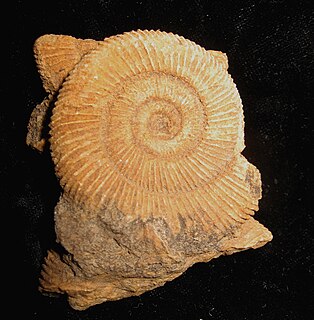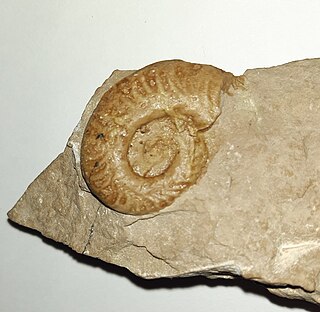
Dactylioceras was a widespread genus of ammonites from the Lower Jurassic period, approximately 180 million years ago (mya).

Stephanoceras is an extinct genus of Stephanoceratoid ammonite which lived during the Bajocian. It is the type genus of the family Stephanoceratidae.

Xipheroceras is a Lower Jurassic ammonite belonging to the Eoderoceratidae, and sometimes placed in the subfamily Xipheroceratinae for which it is the namesake. It has been found in the upper Sinemurian of Europe and possibly Borneo.
Asapholytoceras is a lytoceratid ammonite, originally from the upper Lower Jurassic of southeastern Europe with high, compressed whorls and a sharp angle to the umbilical shoulder. The exposed suture has four primary lobes on either side; the internal dorsal lobe is not cruciform.

Aspidoceras is an extinct ammonoid cephalopod genus belonging to the family Aspidoceratidae.
Frechiella is an ammonite with a smooth, somewhat globose involute shell that lived during the later part of the Early Jurassic, which has been found in England and Italy. The shell is coiled so that the outer whorls cover most of the inner, leaving the inner whorls only slightly exposed. The outer rim, known as the venter, is broadly arched, with either a low narrow keel bordered by small grooves, or a large median groove.

Lytoceratina is a suborder of Jurassic and Cretaceous ammonites that produced loosely coiled, evolute and gyroconic shells in which the sutural element are said to have complex moss-like endings.

Ammonitina comprises a diverse suborder of ammonite cephalopods that lived during the Jurassic and Cretaceous periods of the Mesozoic Era. They are excellent index fossils, and it is often possible to link the rock layer in which they are found to specific geological time periods.

Durotrigensia is a genus of ammonites (Ammonitida) in the perisphinctoid family Parkinsoniidae.
Oecoptychius is an extinct genus of fossil ammonite cephalopods. The species lived during the Middle Jurassic.
Newmarracarroceras is an ammonite from the early middle Jurassic with a ribbed subinvolute shell with a keel running along the venter, or outer rim. The umbilicus is moderately wide, exposing the inner whorls exposed in part.
Metrolytoceras is an extinct cephalopod genus that lived during the Middle Jurassic, characterized by a planispiral evolute shell with smooth middle and outer whorls, flat sides and simplified sutures.

Hildoceras is a genus of ammonite from the Jurassic period in the family Hildoceratidae. The shells are characterized by a narrow discoidal evolute shape, keeled venter, concave ribs along the outer flanks, and a shallow spiral groove running along smooth inner flanks. Whorls slightly overlap, cross sections are compressed. The ventral keel is bordered on either side by a shallow groove. The genus was named by Alpheus Hyatt after Saint Hilda in 1876.

Peltoceras is an extinct ammonite genus from the aspidoceratid subfamily Peltoceratinae that lived during the later part of the Middle Jurassic.
Hecticoceras is an ammonite genus belonging to the haploceratoid family Oppeliidae, that lived during the Middle and Late Jurassic, from the Callovian. Hecticoceras may be seen as a series of some nine subgenera, beginning with the lower Callovian H. (Hecticoceras) and H. (Hecticoceratoides) and ending with the lower Oxfordian H. (Pseudobrightia) and H. (Eochetoceras). Hecticocerassensu lato and Prohecticoceras from the underlying Bathonian form the oppeliid subfamily, Hecticoceratinae.
Blanfordiceras is a strongly ribbed, evolute ammonite included in the perisphinctacean family, Neocomitidae that lived during the latest Jurassic. The shell of Blanfordiceras is discoidal, with evolute coiling and all whorls visible so as to have a broad umbilicus. Exposed whorls are ornamented with strong ribbing that arises from the umbilicus, bifurcating on the outer flanks and extending onto the venter. In general form Blanfordiceras is similar to Berriasella, although with a more rounded whorl section.

Lytoceratidae is a taxonomic family of ammonoid cephalopods belonging to the suborder Lytoceratina, characterized by very evolute shells that generally enlarge rapidly, having whorls in contact but mostly overlapping very sightly, or not at all.
Hemilytoceras is a lytoceratin ammonite genus with round inner whorls, outer whorls becoming depressed and in some developing high lamellae (ribs) that bend forward over the venter. The type species H. immanae came from the Tithonian of Europe. The genus is known from the overall Upper Jurassic of central and southern Europe, North Africa, and western India.
Ochetoceras is a genus of ammonites, belonging to the Oppeliidae, that lived during the Late Jurassic from the early Oxfordian to the early Tithonian, and type for the subfamily Ochetoceratinae.

Hammatoceras is a genus of ammonites belonging to the family Hammatoceratidae which lived during the Toarcian stage of the Early/Lower Jurassic between about 184 and 175 million year ago.









